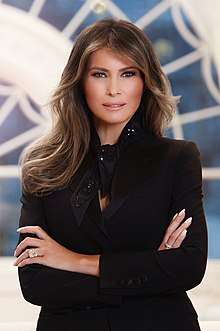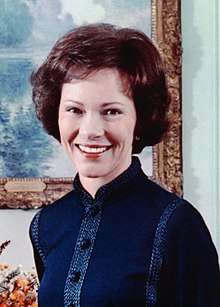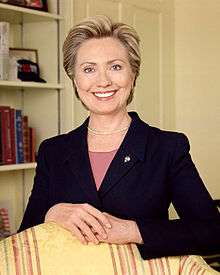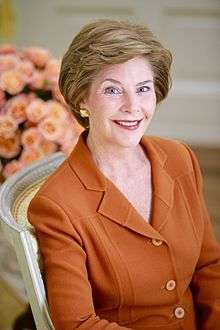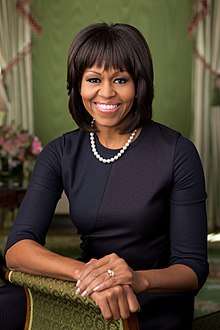First Lady of the United States
First Lady of the United States (FLOTUS) is the title held by the hostess of the White House, usually the wife of the president of the United States, concurrent with the president's term in office. Although the first lady's role has never been codified or officially defined, she figures prominently in the political and social life of the nation.[1] Since the early 20th century, the first lady has been assisted by official staff, now known as the Office of the First Lady and headquartered in the East Wing of the White House.
| First Lady of the United States | |
|---|---|
| Style | Mrs. Trump |
| Abbreviation | FLOTUS |
| Residence | White House |
| Inaugural holder | Martha Washington |
| Formation | April 30, 1789 |
| Website | WhiteHouse.gov |
Melania Trump is the current first lady of the United States, as wife of 45th president of the United States, Donald Trump.
While the title was not in general use until much later, Martha Washington, the wife of George Washington, the first U.S. president (1789–1797), is considered to be the inaugural first lady of the United States. During her lifetime, she was often referred to as "Lady Washington".[2]
Since the 1790s, the role of First Lady has changed considerably. It has come to include involvement in political campaigns, management of the White House, championship of social causes, and representation of the president at official and ceremonial occasions. As first ladies now typically publish their memoirs, which are viewed as potential sources of additional information about their husbands' administrations, and because the public is interested in these increasingly independent women in their own right, first ladies frequently remain a focus of attention long after their husbands' terms of office have ended.[1] Additionally, over the years individual first ladies have held influence in a range of sectors, from fashion to public opinion on policy. Historically, should a president be unmarried, or a widower, the president usually asks a relative or friend to act as White House hostess.
There are four living former first ladies: Rosalynn Carter, wife of Jimmy Carter; Hillary Clinton, wife of Bill Clinton; Laura Bush, wife of George W. Bush; and Michelle Obama, wife of Barack Obama.
Origins of the title
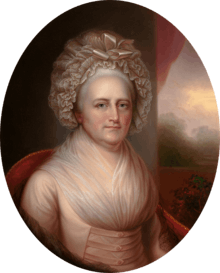
The use of the title First Lady to describe the spouse or hostess of an executive began in the United States. In the early days of the republic, there was not a generally accepted title for the wife of the president. Many early first ladies expressed their own preference for how they were addressed, including the use of such titles as "Lady", "Mrs. President" and "Mrs. Presidentress"; Martha Washington was often referred to as "Lady Washington." One of the earliest uses of the term "First Lady" was applied to her in an 1838 newspaper article that appeared in the St. Johnsbury Caledonian, the author, "Mrs. Sigourney", discussing how Martha Washington had not changed, even after her husband George became president. She wrote that "The first lady of the nation still preserved the habits of early life. Indulging in no indolence, she left the pillow at dawn, and after breakfast, retired to her chamber for an hour for the study of the scriptures and devotion."[3]
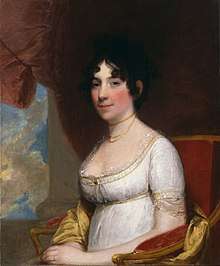
Dolley Madison was reportedly referred to as "First Lady" in 1849 at her funeral in a eulogy delivered by President Zachary Taylor; however, no written record of this eulogy exists, nor did any of the newspapers of her day refer to her by that title.[4] Sometime after 1849, the title began being used in Washington, D.C., social circles. One of the earliest known written examples comes from November 3, 1863, diary entry of William Howard Russell, in which he referred to gossip about "the First Lady in the Land", referring to Mary Todd Lincoln. The title first gained nationwide recognition in 1877, when newspaper journalist Mary C. Ames referred to Lucy Webb Hayes as "the First Lady of the Land" while reporting on the inauguration of Rutherford B. Hayes. The frequent reporting on Lucy Hayes' activities helped spread use of the title outside Washington. A popular 1911 comedic play about Dolley Madison by playwright Charles Nirdlinger, titled The First Lady in the Land, popularized the title further. By the 1930s, it was in wide use. Use of the title later spread from the United States to other nations.
When Edith Wilson took control of her husband's schedule in 1919 after he had a debilitating stroke, one Republican senator labeled her "the Presidentress who had fulfilled the dream of the suffragettes by changing her title from First Lady to Acting First Man."[5]
The wife of the vice president of the United States is sometimes referred to as the second lady of the United States (SLOTUS), but this title is much less common.
Another acronym used is FLOTUS, or First Lady of the United States. According to the Nexis database, the term (which is pronounced FLOW-tus, to rhyme with Potus, and not FLOT-tus) was first used in 1983 by Donnie Radcliffe, writing in The Washington Post.[6][7]
Non-spouses in the role
Several women (at least thirteen) who were not presidents' wives have served as first lady, as when the president was a bachelor or widower, or when the wife of the president was unable to fulfill the duties of the first lady herself. In these cases, the position has been filled by a female relative or friend of the president, such as Jefferson's daughter Martha Jefferson Randolph, Jackson's daughter-in-law Sarah Yorke Jackson and his wife's niece Emily Donelson, Taylor's daughter Mary Elizabeth Bliss, Benjamin Harrison's daughter Mary Harrison McKee, Buchanan's niece Harriet Lane, and Cleveland's sister Rose Cleveland.
Role

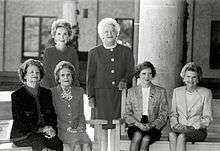
The position of the first lady is not an elected one and carries only ceremonial duties. Nonetheless, first ladies have held a highly visible position in American society.[8] The role of the first lady has evolved over the centuries. She is, first and foremost, the hostess of the White House.[8] She organizes and attends official ceremonies and functions of state either along with, or in place of, the president. Lisa Burns identifies four successive main themes of the first ladyship: as public woman (1900–1929); as political celebrity (1932–1961); as political activist (1964–1977); and as political interloper (1980–2001).[9]
Martha Washington created the role and hosted many affairs of state at the national capital (New York and Philadelphia). This socializing became known as "the Republican Court" and provided elite women with opportunities to play backstage political roles.[10] Both Martha Washington and Abigail Adams were treated as if they were "ladies" of the British royal court.[8]
Dolley Madison popularized the first ladyship by engaging in efforts to assist orphans and women, by dressing in elegant fashions and attracting newspaper coverage, and by risking her life to save iconic treasures during the War of 1812. Madison set the standard for the ladyship and her actions were the model for nearly every first lady until Eleanor Roosevelt in the 1930s.[8] Roosevelt traveled widely and spoke to many groups, often voicing personal opinions to the left of the president's. She authored a weekly newspaper column and hosted a radio show.[11] Jacqueline Kennedy led an effort to redecorate and restore the White House.[12]
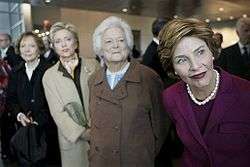
Many first ladies became significant fashion trendsetters.[8] Some have exercised a degree of political influence by virtue of being an important adviser to the president.[8]
Over the course of the 20th century, it became increasingly common for first ladies to select specific causes to promote, usually ones that are not politically divisive. It is common for the first lady to hire a staff to support these activities. Lady Bird Johnson pioneered environmental protection and beautification.[13] Pat Nixon encouraged volunteerism and traveled extensively abroad; Betty Ford supported women's rights; Rosalynn Carter aided those with mental disabilities; Nancy Reagan founded the Just Say No drug awareness campaign; Barbara Bush promoted literacy; Hillary Clinton sought to reform the healthcare system in the U.S.; Laura Bush supported women's rights groups, and encouraged childhood literacy.[8] Michelle Obama became identified with supporting military families and tackling childhood obesity;[14] and Melania Trump has stated that she wants to use her position to help children, including prevention of cyberbullying and supporting children whose lives are affected by drugs.[15]
Near the end of her husband's presidency, Clinton became the first first lady to run for political office. During the campaign, her daughter, Chelsea, took over much of the first lady's role. Victorious, Clinton served as U.S. Senator from New York from 2001 to 2009, when she resigned to become President Obama's Secretary of State until 2013. Clinton was the Democratic Party nominee for president in the 2016 election, but lost to Donald Trump.
Office of the First Lady
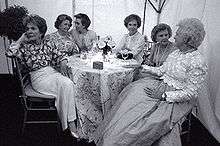
The Office of the First Lady of the United States is accountable to the first lady for her to carry out her duties as hostess of the White House, and is also in charge of all social and ceremonial events of the White House. The first lady has her own staff that includes a chief of staff, press secretary, White House Social Secretary, and Chief Floral Designer. The Office of the First Lady is an entity of the White House Office, a branch of the Executive Office of the President.[16] When First Lady Hillary Clinton decided to pursue a run for Senator of New York, she set aside her duties as first lady[17] and moved to Chappaqua, New York to establish state residency.[18] She resumed her duties as first lady after winning her senatorial campaign,[19] and retained her duties as both first lady and U.S. Senator for the seventeen-day overlap before Bill Clinton's term came to an end.[20]
Despite the significant responsibilities usually handled by the first lady, the first lady does not receive a salary. This has been criticized by both Ronald Reagan and Barack Obama.[21]
Exhibitions and collections
Established in 1912, the First Ladies Collection has been one of the most popular attractions at the Smithsonian Institution. The original exhibition opened in 1914 and was one of the first at the Smithsonian to prominently feature women. Originally focused largely on fashion, the exhibition now delves deeper into the contributions of first ladies to the presidency and American society. In 2008, "First Ladies at the Smithsonian" opened at the National Museum of American History as part of its reopening year celebration. That exhibition served as a bridge to the museum's expanded exhibition on first ladies' history that opened on November 19, 2011. "The First Ladies" explores the unofficial but important position of first lady and the ways that different women have shaped the role to make their own contributions to the presidential administrations and the nation. The exhibition features 26 dresses and more than 160 other objects, ranging from those of Martha Washington to Michelle Obama, and includes White House china, personal possessions and other objects from the Smithsonian's unique collection of first ladies' materials.[22]
First lady and fashion
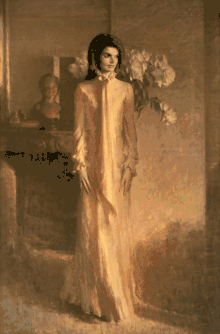
Some first ladies have garnered attention for their dress and style. Jacqueline Kennedy Onassis, for instance, became a global fashion icon: her style was copied by commercial manufacturers and imitated by many young women, and she was named to the International Best Dressed List Hall of Fame in 1965.[23][24] Michelle Obama has also received significant attention for her fashion choices: style writer Robin Givhan praised her in The Daily Beast, arguing that the First Lady's style has helped to enhance the public image of the office.[25]
List of first ladies of the United States and their causes
Over the course of the 20th century, it became increasingly common for first ladies to select specific causes to promote, usually ones that are not politically divisive. It is common for the first lady to hire a staff to support these activities.
| First Lady | Tenure | Cause(s) | |
|---|---|---|---|
| Eleanor Roosevelt | March 4, 1933 – April 12, 1945 | Women's rights, civil rights, and humanitarian efforts |  Giving kids free food and water in Hyde Park |
| Mamie Eisenhower | January 20, 1953 – January 20, 1961 | Farmer | 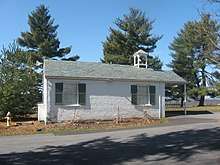 The Eisenhower farm |
| Jacqueline Bouvier Kennedy | January 20, 1961 – November 22, 1963 | White House restoration and the arts | 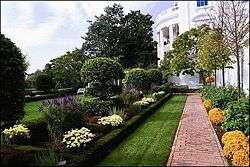 The Kennedy Rose Garden, pioneered by Jaqueline Kennedy |
| Lady Bird Johnson | November 22, 1963 – January 20, 1969 | Environmental protection and beautification |  Lady Bird Johnson oversees the planting of a dogwood as a part of her beautification. |
| Pat Nixon | January 20, 1969 – August 9, 1974 | Volunteerism |  Pat Nixon |
| Betty Ford | August 9, 1974 – January 20, 1977 | Women's rights |  Betty Ford showing her support publicly for the Equal Rights Amendment |
| Rosalynn Smith Carter | January 20, 1977 – January 20, 1981 | Mental health | 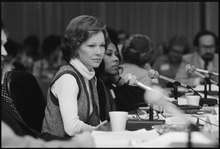 Rosalynn Carter chairs mental health hearings. |
| Nancy Reagan | January 20, 1981 – January 20, 1989 | "Just Say No"; drug awareness | 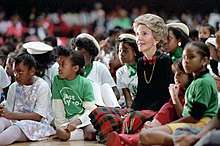 Nancy Reagan attending a "Just Say No" rally with children |
| Barbara Pierce Bush | January 20, 1989 – January 20, 1993 | Childhood literacy |  Barbara Bush reading to a group of schoolchildren |
| Hillary Rodham Clinton | January 20, 1993 – January 20, 2001 | Healthcare | .jpg) Hillary Clinton during her presentation at a congressional hearing on healthcare reform |
| Laura Welch Bush | January 20, 2001 – January 20, 2009 | "Ready to Read, Ready to Learn"; childhood literacy | 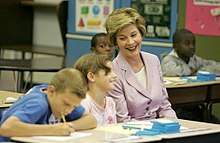 Laura Bush observes a fifth-grade math class. |
| Michelle Obama | January 20, 2009 – January 20, 2017 | "Let's Move!"; reducing childhood obesity | 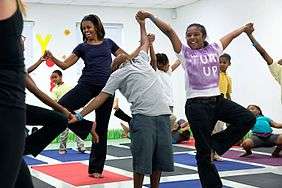 Michelle Obama joins children for a yoga class during a "Let's Move!" after school activities event. |
| Melania Trump | January 20, 2017–present | "Be Best"; cyberbullying awareness | 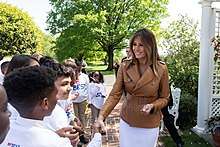 Melania Trump attending a "Be Best" rally with children |
Living first ladies
As of June 2020, there are four living former first ladies, as identified below.
The most recent first lady to die was Barbara Bush (served 1989–1993), on April 17, 2018, at the age of 92. The greatest number of former first ladies to be alive at one time was ten, during the period from June 2, 1886 to August 23, 1887, when Sarah Yorke Jackson, Priscilla Cooper Tyler, Julia Gardiner Tyler, Sarah Childress Polk, Harriet Lane, Julia Grant, Lucy Webb Hayes, Lucretia Garfield, Mary Arthur McElroy, and Rose Cleveland were all alive; and the period from March 4 to June 25, 1889, when Priscilla Cooper Tyler, Julia Gardiner Tyler, Sarah Childress Polk, Harriet Lane, Julia Grant, Lucy Webb Hayes, Lucretia Garfield, Mary Arthur McElroy, Rose Cleveland, and Frances Folsom Cleveland Preston were alive.
See also
- First Ladies: Influence & Image
- First Ladies National Historic Site (Canton, Ohio)
- List of current United States first spouses
- First Spouse $1 Coin Program
References
- Caroli, Betty Boyd. "First Lady: United States title". Encyclopædia Britannica. Retrieved September 30, 2016.
- Figueroa, Acton (January 1, 2003). Washington, Part 3. World Almanac Library. p. 10. ISBN 978-0-8368-5162-5.
- "Martha Washington". St. Johnsbury Caledonian. August 7, 1838. p. 1.
- "First Lady Biography: Dolley Madison". National First Ladies' Library.
- Creeden, Sharon (1999). In Full Bloom: Tales of Women in Their Prime. August House. p. 30. ISBN 9780874835762.
- Safire, William (October 12, 1997). "On Language; Potus And Flotus". The New York Times. Archived from the original on June 18, 2019.
- "FLOTUS". Merriam-Webster. Retrieved January 28, 2020.
- Anthony, Carl Sferrazza (September 26, 2008). "The Role of the First Lady". America.gov. Archived from the original on May 10, 2009. Retrieved May 4, 2009.
- Burns, Lisa M. (2008). First Ladies and the Fourth Estate: Press Framing of Presidential Wives. DeKalb, IL: Northern Illinois University Press. ISBN 978-0-87580-391-3.
- Shields, David S. & Teute, Fredrika J. (2015). "The Republican Court and the Historiography of a Women's Domain in the Public Sphere". Journal of the Early Republic. 35 (2): 169–183. doi:10.1353/jer.2015.0033.
- O'Farrell, Brigid (2010). She was one of us: Eleanor Roosevelt and the American worker. Ithaca, NY: Cornell University Press.
- Troy, Gil (2001). "Jacqueline Kennedy's White House renovations". White House Studies. 1 (3): 395–404.
- Gould, Lewis L. (1988). Lady Bird Johnson and the environment. University Press of Kansas.
- "Michelle Obama". The White House. Retrieved May 4, 2010.
- Superville, Darlene (October 9, 2017). "Melania Trump Filling Out Her Agenda as First Lady". U.S. News & World Report. Associated Press. Retrieved November 8, 2017.
- "Executive Office of the President". The White House. December 23, 2014.
- "Hillary Clinton Makes a Historic Move".
- "Mrs. Clinton to Be Official New Yorker". The New York Times. November 24, 1999.
- "The Race Won, the Senator-Elect Resumes Her First Lady Duties at the White House". The New York Times. November 10, 2000.
- "A Day of Firsts As Mrs. Clinton Takes the Oath". The New York Times. January 4, 2001.
- Finkelstein, Sarina (April 12, 2016). "Want to Fix Wage Inequality? Start With the First Lady". Money. Retrieved February 6, 2017.
- "The First Ladies". National Museum of American History, Smithsonian Institution. Retrieved April 4, 2012.
- "World's Best Dressed Women". The International Hall of Fame: Women. Vanity Fair. 1965. Archived from the original on July 12, 2013. Retrieved February 15, 2012.
- Zilkha, Bettina (2004). Ultimate Style: The Best of the Best Dressed List. New York, NY: Assouline. pp. 64–69, 90. ISBN 2-84323-513-8.
- Givhan, Robin (2012). "First Lady Fashion Fatigue". The Daily Beast. Retrieved October 30, 2014.
Further reading
- Jeanne E. Abrams. First Ladies of the Republic: Martha Washington, Abigail Adams, Dolley Madison, and the Creation of an Iconic American Role. New York New York University Press, 2018. ISBN 978-1-4798-8653-1.
- Anthony, Carl Sferrazza (1992). First Ladies: The Saga of the Presidents Wives and Their Power 1789–1961. New York: Quill/William Morrow. ISBN 978-0-688-11272-1. excerpt and text search
- Bailey, Tim (Spring 2013). "America's First Ladies on Twentieth-Century Issues: A Common Core Unit". History Now. 35. Curriculum unit based on primary sources.
- Berkin, Carol, ed. (Spring 2013). "America's First Ladies". History Now. 35. Popular essays by scholars.
- Böck, Magdalena (2009). The Role of First Ladies: A Comparison Between the US and Europe (eBook ed.). Munich: GRIN Verlag. ISBN 978-3-640-42153-4.
- Brower, Kate Andersen (2016). First Women: The Grace and Power of America's Modern First Ladies. New York: Harper. ISBN 978-0-06-243965-9.
- Caroli, Betty Boyd. "The Role of First Lady" in Graff, Henry F., ed. The presidents: A Reference History (3rd ed. 2002) online
- Deppisch, Ludwig M. (2015). The Health of the First Ladies: Medical Histories from Martha Washington to Michelle Obama. McFarland.
- Hummer, Jill Abraham. First Ladies and American Women: In Politics and at Home (UP of Kansas, 2017); 269 pages;
- Lugo-Lugo, Carmen R. & Bloodsworth-Lugo, Mary K. (2011). "Bare Biceps and American (In) Security: Post-9/11 Constructions of Safe(ty), Threat, and the First Black First Lady". Women's Studies Quarterly. 39 (1): 200–217. doi:10.1353/wsq.2011.0030. On media images of Michelle Obama.
- Pastan, Amy (2008). First Ladies. London: DK. ISBN 978-0-7894-7398-1. Heavily illustrated.
- Roberts, John B. (2004). Rating The First Ladies: The Women Who Influenced the Presidency (2nd ed.). New York: Citadel Press. ISBN 978-0-8065-2608-9. excerpt and text search
- Schwartz, Marie Jenkins. Ties That Bound: Founding First Ladies and Slaves (U of Chicago Press, 2017), 420 pp.
- Troy, Gil (1997). Affairs of State The Rise and Rejection of the Presidential Couple Since World War II. By a leading political historian.
- Truman, Margaret (1996). First Ladies: An Intimate Group Portrait of White House Wives. New York: Facett Columbine. ISBN 978-0-449-22323-9. excerpt and text search
- Watson, Robert P. (2003). "Toward the Study of the First Lady: The State of Scholarship". Presidential Studies Quarterly. 33 (2): 423–441. doi:10.1111/j.1741-5705.2003.tb00038.x.
External links
- Alphabetical List of First Ladies of the United States – Library of Congress website
- Office of the First Lady – WhiteHouse.gov
- First Lady's Gallery – WhiteHouse.gov
- The National First Ladies' Library
- The First Ladies at the Smithsonian – an online exhibition from the National Museum of American History, Smithsonian Institution
